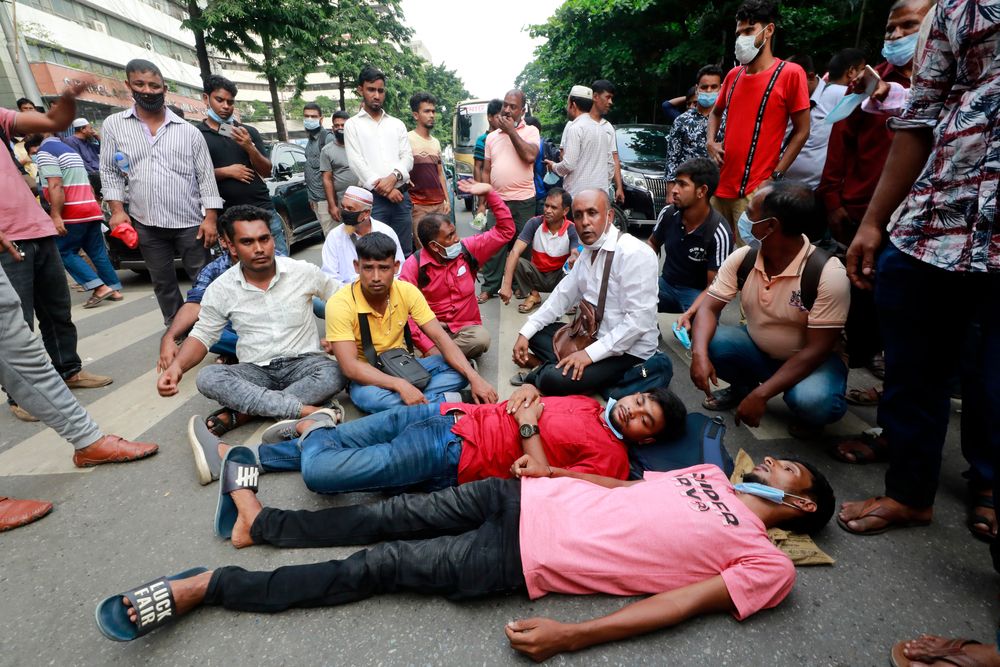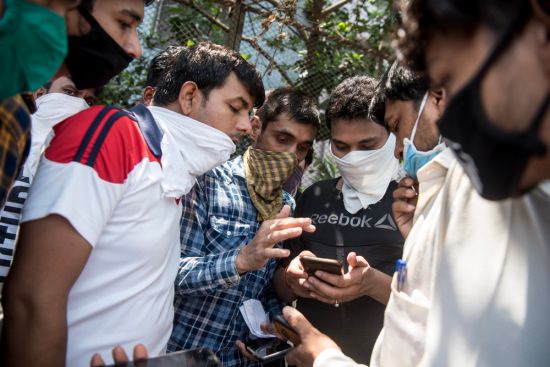Migrant labor has long been associated with deception, exploitation and challenges to the rule of law. The economic downturn triggered by the Covid-19 pandemic has prompted large-scale layoffs and deportations. As Michael Gallo and Hannah Thinyane of the United Nations University Institute in Macau write, the unprecedented wave of returnees will have dramatic implications for national development strategies. They demonstrate how technology may play a role in policy and programmatic responses.
Pandemic or no, they want to go: Migrant workers outside an airline's office in Dhaka, Bangladesh, protest the lack of flights to Saudi Arabia (Credit: Sk Hasan Ali / Shutterstock.com)
The Covid-19 pandemic has ravaged the world for over a year, resulting in multifold crises with devasting economic and social impact. Perhaps the most dramatically affected areas aside from health have been employment and human mobility, with deep recessions resulting in mass unemployment and border restrictions inhibiting travel between and within countries. Migrant workers around the world have borne a disproportionate burden of these adverse consequences, with harsh containment measures, xenophobia, and a lack of social protection measures further exacerbating their oftentimes highly precarious immigration and work situations.
The transnational recruitment of migrant workers has long been marred by deception, exploitation and irregularities, and Covid-19 has substantially increased the immediate and long-term risks of abuse. Shrinking demand for placements, an oversupply of low-wage laborers without work, ongoing travel restrictions, and government efforts to nationalize workforces all contribute to increased competition and pressure for the finite number of overseas employment opportunities. This may push migrants, who are now in even more dire circumstances, to undertake riskier border crossings, take out larger loans to finance recruitment costs, and become further reliant on unscrupulous brokers as they try desperately to find whatever work is available.
Increased demand for manufacturing in specific sectors such as personal protective equipment, medical supplies and even toys (as parents attempt to entertain their children at home during lockdowns) can also lead to excessive working hours and harsh conditions as factories try to meet orders of unprecedented size. Simultaneously, many companies are slashing their budgets for compliance mechanisms, leaving workers in situations of exploitation unidentified and unreported.
Not only have many countries in Asia demonstrated noteworthy success in handling the coronavirus pandemic, but they have also been leading the way in designing innovative digital technologies to meet the varying needs of these temporary and circular migrant workers. As Asian economies are leading the global race to economic recovery, ensuring adequate oversight and protection of workers’ rights will remain a top policy priority for migration governance, particularly within popular source countries. Intraregional migration is a major driver of economic growth – and border closures notwithstanding, this trend will be a defining contributor to development outcomes for decades to come. Perhaps most evident of the forward thinking and intergovernmental cooperation in recognizing the transformational potential of technology was the 2018 ASEAN Forum on Migrant Labour hosted in Singapore under the theme of “digitalization to promote decent work for migrant workers”.
Increasingly reliant on information and communication technologies for every step of their recruitment and employment journeys, migrant workers utilize a wide range of digital tools and platforms to seek information, access services and keep in touch with loved ones. These solutions span a wide breadth of functionalities and address core processes associated with overseas employment such as information provision, remittances, skills recognition, job matching, and access to justice. New technologies and digitized processes have been rolled out in direct response to immediate Covid-19-related needs and more broadly, the pandemic is accelerating digital transformations across the full breadth of migration-related stakeholders.
Prospective migrants are subject to extortionate fees, information asymmetries, and fraudulent practices that are systematically enabled by the multiple and opaque layers that lie between a jobseeker and a company looking to hire. One way technology has been used to promote fair recruitment is by eliminating the need for brokers or middlemen through direct job-matching platforms. We can see this approach being replicated across different low-skilled sectors like construction and domestic work in a number of different Asian countries with bespoke platforms such as BongPheak in Cambodia, Sama in Singapore, Pink Collar in Malaysia, and HelperChoice in Hong Kong. By centralizing verified job listings and providing the enabling technical capacity for both workers and employers, these sites can greatly enhance transparency and labor-market efficiency.
Large-scale layoffs and deportations caused by the economic downturn will continue to challenge and strain systems for return and reintegration within major source countries. In Gulf Cooperation Council (GCC) countries such as the United Arab Emirates, up to 90 percent of the population are migrant workers, and these oil-dependent economies have been hit particularly hard due to decreased demand and falling prices, triggering a mass exodus of foreigners. Kuwait has passed legislation that will see some 360,000 migrant workers deported and an estimated 1.2 million expatriate workers will leave Saudi Arabia. Both countries draw an overwhelming majority of their migrant workforce from Asia. More than half a million Nepalis and 200,000 Filipinos were expected to return home last year, significantly affecting the flow of remittances home that are a lifeline for so many families. Given the size and scope of outward migration for employment throughout the region, this unprecedented wave of returnees will have dramatic implications for national development strategies, and technology may play a role in policy and programmatic responses.
Many returning migrants have acquired various occupational and technical skills while working abroad or in a different state of their home country. However, few systems exist for facilitating skills recognition and matching labor-market needs once they have returned home. Identifying and connecting these migrants with relevant skillsets can help close gaps in domestic labor markets and optimize the chances of successfully reintegrating in their home country.
Social compliance audits are a common tool to monitor factory working conditions. While typically undertaken in person and consisting of walk-throughs, document inspections and worker interviews, in many countries, movement restrictions have forced companies to reshape their modus operandi for auditing. In other cases, cost-cutting measures are downsizing sustainability departments, with auditors instead extending the compliance ratings for factories from previous years.
Other companies are investing in their sustainability teams and exploring how digital technologies can support them in their oversight of supply chains. Worker voice tools such as Apprise Audit, which is being used in supply chains throughout Asia, has been modified to collect and analyze information, even in the absence of an auditor. Workers can self-report whether or not health guidance is being followed, if they have been paid on time, or if they are being confined to cramped dormitories without freedom of movement, providing timely information on common indicators of exploitation.
Digital technology is a crucial factor underpinning innovation and driving improvements in governance and service delivery in the 21st century. It is inevitable that the many forms of digital technology have a central role to play in facilitating safe, orderly and dignified labor migration and ensuring the protection of rights of migrant workers through every step of the recruitment life cycle.
Covid-19 has disrupted our economic and social systems and while some countries may turn inward, others will eagerly look to the rest of the world for key insights on the road to recovery. The region with the highest share of international migrants worldwide should continue to build upon its strengths and experiences advancing digital solutions for migrant workers.
Further reading:
Michael Gallo
United Nations University Institute in Macau
Hannah Thinyane
United Nations University Institute in Macau
Check out here for more research and analysis from Asian perspectives.




